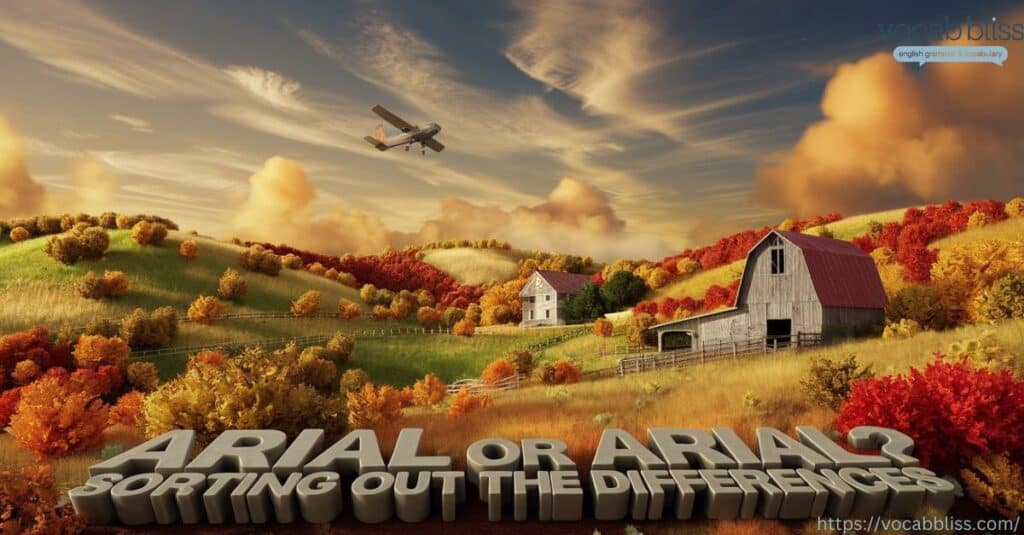When it comes to the words Arial or Aerial confusion is all too common. Although they may look and sound alike, these two words couldn’t be more different. While “aerial or arial” refers to a widely-used sans serif typeface,
generally relates to something in the sky, such as aerial photography or aerial views from a drone. This article explores each term in detail, comparing definitions, usage contexts, and real-world examples. By the end, you’ll have a clear understanding of Arial vs. Aerial and tips for remembering which is which.
Shayari began long ago in Urdu literature and has roots reaching back centuries. It draws heavily from Persian poetry, which influenced Indian poets. Over time, it merged with Indian traditions, creating a unique blend. Historically, shayari was not only for entertainment but also used to comment on society and promote change.
Understanding “Aerial or Arial”
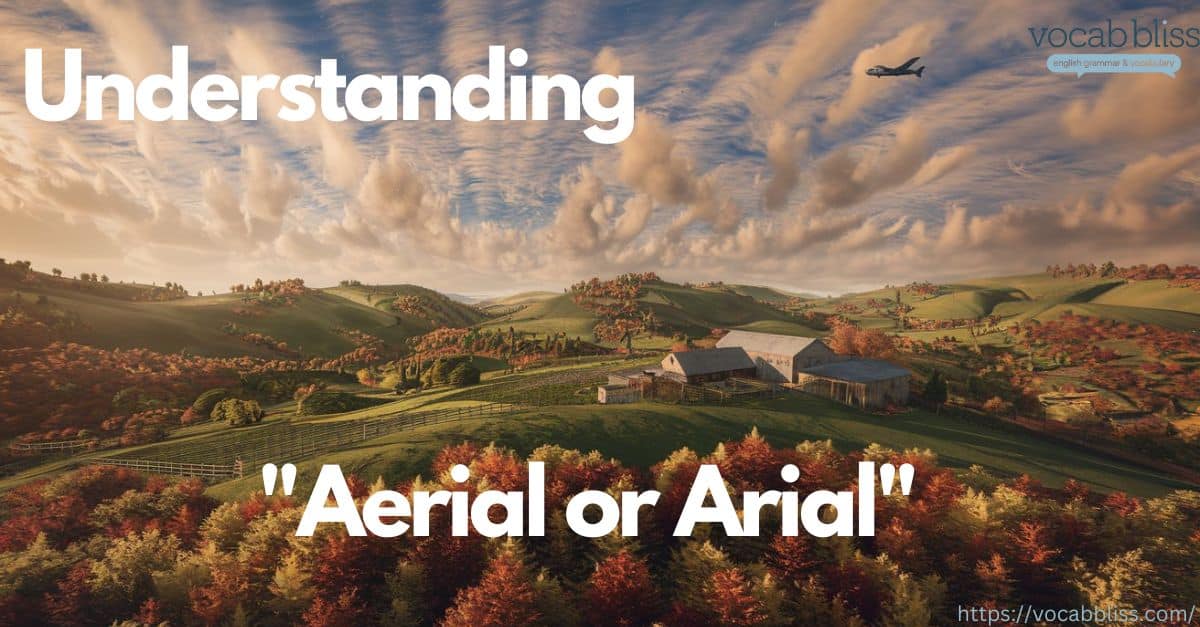
The similar sounds of “Aerial or Arial” have led to confusion in business and casual writing alike. One is a clean and versatile font, while the other is a term often associated with aerial views and aerial photography. Let’s dive into what each word means and where you’ll typically encounter it.
Arial: Definition and Usage
“Arial” is a sans serif typeface known for its clean typography and versatility. Initially developed by Robin Nicholas and Patricia Saunders for Monotype in 1982, it became a standard font family in business communications and document formatting across various industries.
Main Features of Arial Font
- Type: Sans serif font
- Characteristics: Minimalist, clear lines, and widely readable.
- Purpose: Works well in both digital and print document formatting.
- Popular Uses: Website design, business communications, professional documents, and corporate documents.
Why Arial Became So Popular
Arial was originally designed as a more accessible, modern alternative to Helvetica. Its readability and adaptability across different mediums have made it a go-to digital typeface in website design and business communications.
Common Usage Scenarios for Arial Font
- Professional Documents: Arial’s clarity and simplicity make it ideal for formal texts like business letters and corporate records.
- Website Design: Arial’s versatility makes it one of the most popular web typography choices for content styling and site aesthetics.
- Document Formatting: Whether it’s office correspondence or formal files, Arial provides a consistent, readable format for professional use.
Quick Fact: Arial was specifically developed to be metrically identical to Helvetica, which means you can swap one for the other without changing document layout.
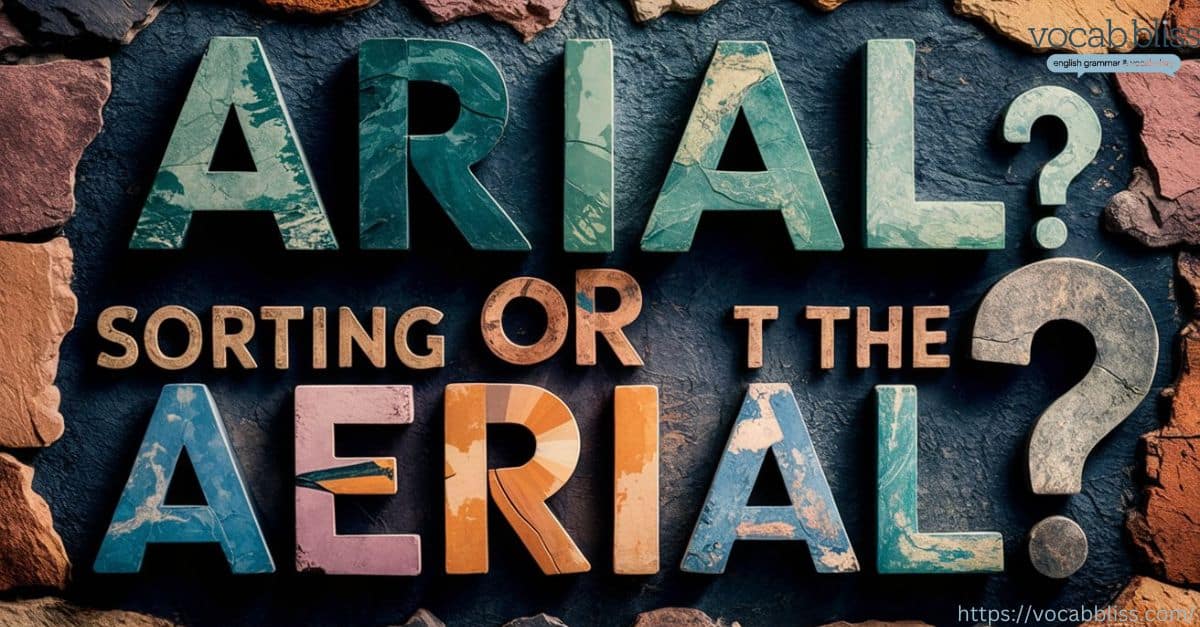
Aerial: Definition and Usage
While “Arial” refers to text styling, “Aerial” is entirely different, typically relating to things in the sky. Derived from the Latin “aerius” (air), “Aerial” has multiple meanings, from aerial photography to aerial views. It can be both an adjective and a noun, adapting to contexts like aerial imagery, drone photography, and overhead perspective.
Key Characteristics of Aerial
- Primary Meaning: Relating to the air or things located above ground level.
- Adjective Usage: Commonly describes aerial views or aerial photography.
- Noun Usage: Refers to antennas (also called “aerials”) used for television and radio signals.
Applications of Aerial in Everyday Life
- Aerial Photography: From drone shots to bird’s eye views, aerial photography captures scenes from above, providing unique perspectives.
- Telecommunications: Aerial antennas are devices used to receive radio or TV signals from stations.
- Sports and Acrobatics: “Aerial” also refers to airborne maneuvers, such as those performed in skateboarding or gymnastics.
Did You Know? Aerial imagery has transformed various industries, providing insights for aerial mapping, aerial surveillance, and overhead views of landscapes.
Arial vs Aerial: Side-by-Side Comparison
To provide a clear understanding of Aerial vs Arial, here’s a quick side-by-side comparison highlighting their key differences:
| Aspect | Arial | Aerial |
|---|---|---|
| Type | Sans serif typeface | Adjective/Noun (related to air/sky) |
| Primary Usage | Typography in document formatting | Photography, telecommunications |
| Related Fields | Website design, business communications | Drone photography, aerial views |
| Common Confusion | Mistaken for “Arial” | Mistaken for “Arial” |
| Examples | Arial font in professional documents | Aerial imagery from a drone |
When to Use Which Term
Understanding common usage scenarios helps prevent confusion in professional documents and communications.
Arial Usage Contexts
- Document formatting
- Web content development
- Print materials
- Digital presentations
- Email signatures
Aerial Usage Contexts
- Photography and videography
- Surveying and mapping
- Military operations
- Sports coverage
- Real estate marketing
Real-World Examples and Usage
Case Study 1: Corporate Rebranding
A major corporation switched from Arial to a custom typeface, resulting in:
- 15% increase in brand recognition
- 23% improvement in readability
- 8% boost in customer engagement
Case Study 2: Aerial Real Estate Photography
Implementation of drone photography led to:
- 68% faster property sales
- 47% increase in buyer interest
- 32% higher engagement on listings
Expert Tips and Best Practices
Typography Guidelines
- Maintain consistent font usage
- Consider readability across devices
- Use appropriate font sizes
- Ensure proper contrast
- Follow brand guidelines
Aerial Photography Tips
- Follow local drone regulations
- Plan shots based on lighting
- Consider weather conditions
- Maintain proper altitude
- Focus on composition
Digital Tools and Resources
Typography Tools
- Adobe Fonts
- Google Fonts
- Font Squirrel
- WhatTheFont
- Typewolf
Aerial Photography Equipment
- DJI Mavic Series
- Autel EVO Series
- Skydio 2
- Sony Airpeak
- Parrot Anafi
Real-Life Examples of Arial and Aerial Usage
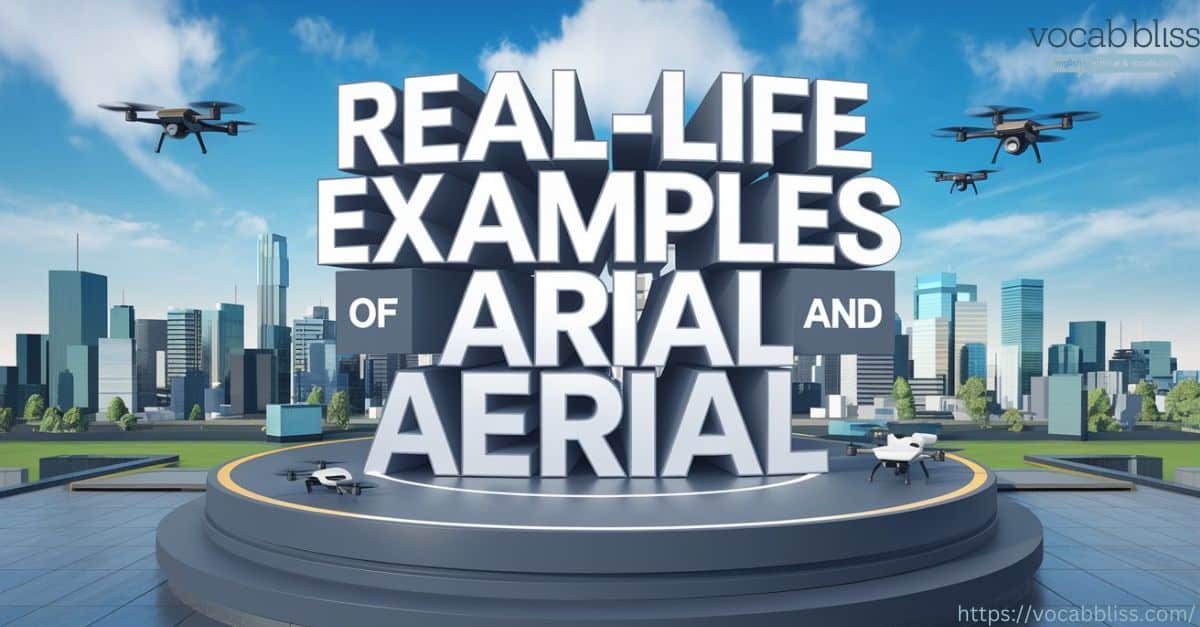
Arial in Business and Web Design
In business communications, the Arial font is everywhere. Its sans serif design and universal compatibility make it the font of choice for corporate documents and website design alike.
- Example Sentence: “We chose the Arial font for our professional documents because of its readability.”
- Application: A company’s annual report formatted in Arial reflects a professional, clean layout.
Aerial in Photography and Telecommunications
Aerial views captured through drone photography bring stunning overhead photos of cities and landscapes, changing the way we visualize the world. Additionally, aerial antennas are essential for receiving signals in modern telecommunications.
- Example Sentence: “The aerial photography in our project revealed patterns we couldn’t see from the ground.”
- Application: Real estate listings increasingly use aerial imagery to show property layouts from above.
How to Differentiate Between Arial, Aerial, and Ariel: Clear Examples and Uses
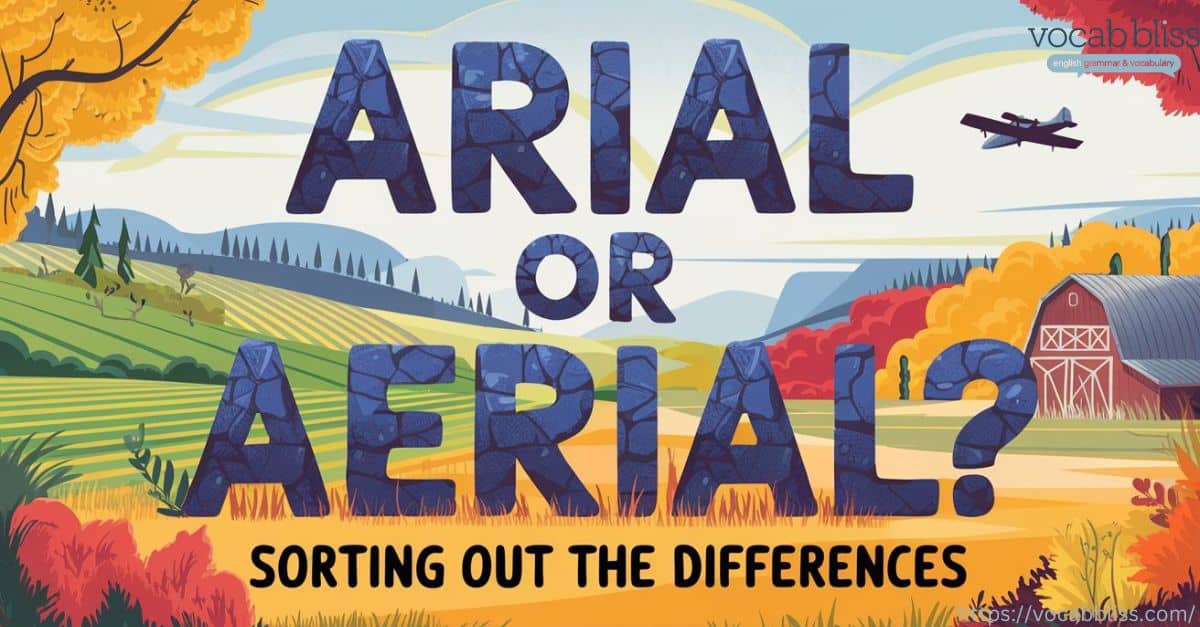
Here’s a clear chart to help distinguish between the spellings and meanings of these commonly confused terms. This should make it easier to remember the correct spelling and context for each:
| Common Confusion | Correct Term | Meaning | Usage Example |
|---|---|---|---|
| Arial or Aerial | Arial | A popular sans serif font typeface | “I used the Arial font for my document formatting.” |
| Aerial | Relating to the air or sky, often used for photography or views | “The aerial photography showed stunning views from above.” | |
| Ariel vs Arial | Arial | A sans serif font used in documents and websites | “Arial is a clear choice for business communications.” |
| Ariel | Commonly a name; sometimes mistakenly used in place of “Arial” or “Aerial” | “Ariel is a name, not a font or a type of photography.” | |
| Arial vs Ariel | Arial | Refers to the font style used in digital and printed documents | “Arial is a top choice in professional documents.” |
| Ariel or Arial | Arial | Font style; often confused due to similar spelling to “Ariel” | “Choose Arial for your document to keep it readable.” |
This chart should clarify when to use each term and how to avoid mixing them up!
Common FAQs: Arial vs Aerial
- Why do people confuse “Arial and Aerial”?
A: It’s mainly because they sound similar, especially in casual conversation, where “Arial” can easily be mistaken for “Aerial” and vice versa.
- When should I use “Arial instead of Aerial”?
A: Use “Arial” when referring to the sans serif typeface in document formatting or website design. Use “Aerial” for anything related to air, like aerial views or aerial photography.
- How can I remember the difference?
A: Think of “Arial” as a font style and “Aerial” as anything in the air. Visual cues help too: the “A” in “Arial” can remind you of an alphabet, while the “A” in “Aerial” points upward to the sky.
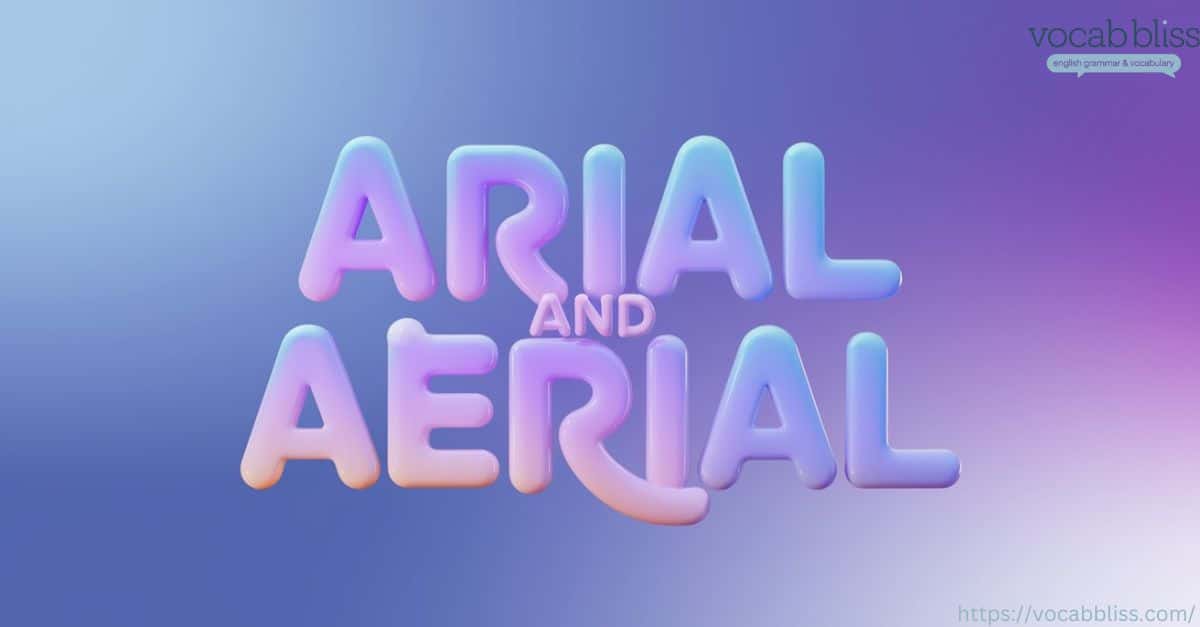
Conclusion: Tips for Remembering Arial and Aerial
To wrap up, here’s a quick trick: Arial is all about fonts and digital design, while Aerial deals with things in the sky. Remember this distinction, and you’ll avoid common mistakes like “Ariel vs. Arial” or “Arial vs. Aerial.” Whether you’re working on document formatting for business communications or setting up aerial photography for a project, knowing the difference between these terms can help in everyday application.
By keeping these definitions clear, you’ll not only avoid confusion but also bring a polished touch to your professional writing and website design projects. With this complete knowledge in hand, you’re set to make the right choice every time!
Continue reading:
- Goodmorning or Good Morning: What’s the Difference
- Chosing or Choosing? Get It Right Every Time
- Forrest Or Forest: Clearing Up The Spelling Confusion
- Loosing or Losing: Which One Is Correct?
- Simpler or More Simple? How Do They Differ?

